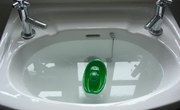Grab your soccer ball, it’s time for math! Though no longer in vogue, for decades the spherical object kicked around at the World Cup was stitched together with 20 hexagons and 12 pentagons. But that’s not the only way you recognize this polygon. To completely appreciate the hexagon dimensions you must acknowledge the shape of the honeycomb constructed by the geometrical genius of bees. You know the hexagon is everywhere, but how do you measure it?
The easiest way to construct a regular hexagon is by drawing six equilateral triangles that all have a common vertex in the central point of the hexagon.
The internal hexagon angles at each of the six vertices measures 120°. The total number of hexagon diagonals is equal to nine. Three of these are long diagonals that cross the central point, and the other six are also called the "height" of the hexagon.
Calculating the Diameter of a Hexagon
First, measure all the other sides of the hexagon to make sure the hexagon is regular. In a regular hexagon, all six sides will be equal. If the hexagon is irregular, it will not have a diameter.
Next, there are two simple ways to calculate the diameter of a hexagon.
- Measure the side length and multiply it by 2.
- Multiply the radius by 2. (The distance from the intersection of the two sides to the center is called the radius.)
Tip
Remember, to find the area of a triangle, multiple the base by the height and then divide by 2
Finding the Area of a Regular Hexagon
- Split the figure into triangles.
- Calculate the area of one triangle. Remember, to find the area of a triangle, multiply the base by the height, and then divide by 2.
- Now, multiply that value by 6.
Measuring Hexagon Angles
To find the sum of the interior angles of a hexagon, divide it up into four equal triangles. Because the sum of the angles of each triangle is 180 degrees, you get:
4 𝗑 180° = 720°
So the sum of the interior angles of a hexagon is 720 degrees.
Measuring the Interior Angles
All sides of a regular hexagon are congruent (the same length), and all the interior angles are also congruent. So to measure the interior angles, you take the sum of all the angles which is 720 degrees and divide it by the number of angles, which is 6.
720° ÷ 6 = 120°
So 720 degrees divided by 6 equals 120 degrees.
The measure of the interior angle of a regular hexagon is 120 degrees.
Measuring the Central Angle
First, make a circle in the middle of the hexagon. You know a circle is 360 degrees around. So all you have to do is divide that by six angles.
360° ÷ by 6 = 60°
The measure of the central angle of a regular hexagon is 60 degrees.
A hexagon layout calculator can be a helpful tool for basic measurement questions about the hexagon. Designers as well as carpenters often use them to help layout a perfect hexagon pattern in the designing and building of tile floors or glass windows or even playground equipment.











